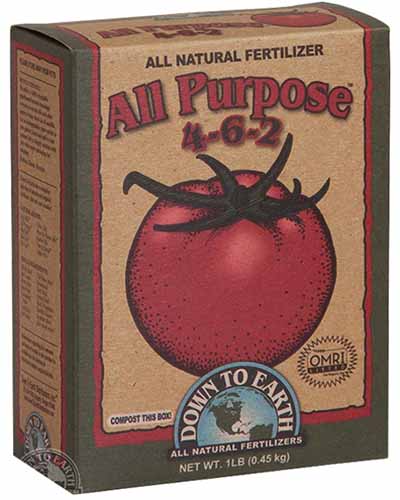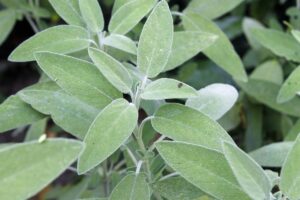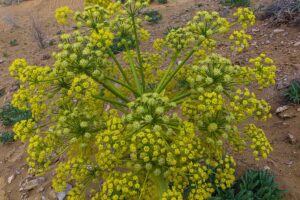Allium sativum var. ophioscorodon ‘Polish Hardneck’
‘Polish Hardneck’ – which doesn’t hail from Poland, but rather, from Ontario, Canada – is the ultimate garlic-lover’s garlic.
It has a pungent, spicy flavor that mellows out with cooking, but it’s not so hot that you’ll be breathing sulfuric fumes onto all your friends for the next few days.
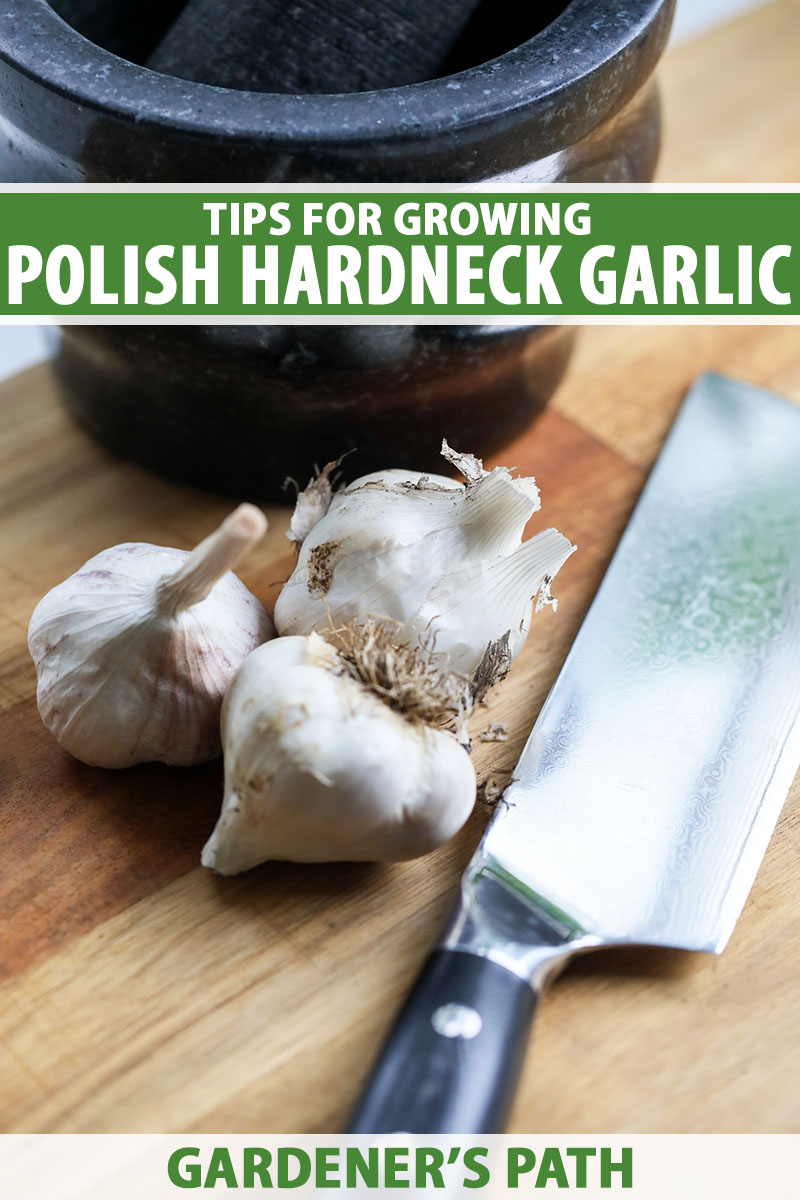
We link to vendors to help you find relevant products. If you buy from one of our links, we may earn a commission.
Each clove is rich and deep, with a musky, intense, searing kick, all wrapped up in a loose skin that makes peeling a breeze.
And as you probably guessed, ‘Polish Hardneck’ is a hardneck type, which means it stores well for a long time.
You can learn more of the basics in our guide to growing garlic.
In this article, we’ll talk all about where this garlic cultivar came from and how to grow it in your garden. Here’s what you can expect:
What You’ll Learn
Before we dive in, let’s clarify a few things. There are two varieties of garlic: hardneck (var. ophioscorodon) and softneck (var. sativum).
Hardnecks have a hard central stalk that forms a flower head, though we usually remove these to encourage larger bulb production.
Hardneck types are planted in the fall so they can have a period of cold, known as vernalization.
Within the hardneck subspecies, there are three groups: porcelain, purple striped, and rocambole. By the way, if you want to know more about the different groups, we have a guide that explains the 10 groups of garlic in detail.
Porcelain cultivars have only recently gained attention in the US, but in the past 15 years, they have exploded on the market.
These are typically large cultivars with white skin and bold flavors, though there is some variation among them. ‘Polish Hardneck’ is a porcelain group cultivar.
Cultivation and History
‘Polish Hardneck’ was first cultivated in Ontario, Canada by allium grower John Yovanov and imported to the US by Rick Bangert.
Bangert gave some of the bulbs to Filaree Farm, and Filaree has helped to distribute this variety in the United States.
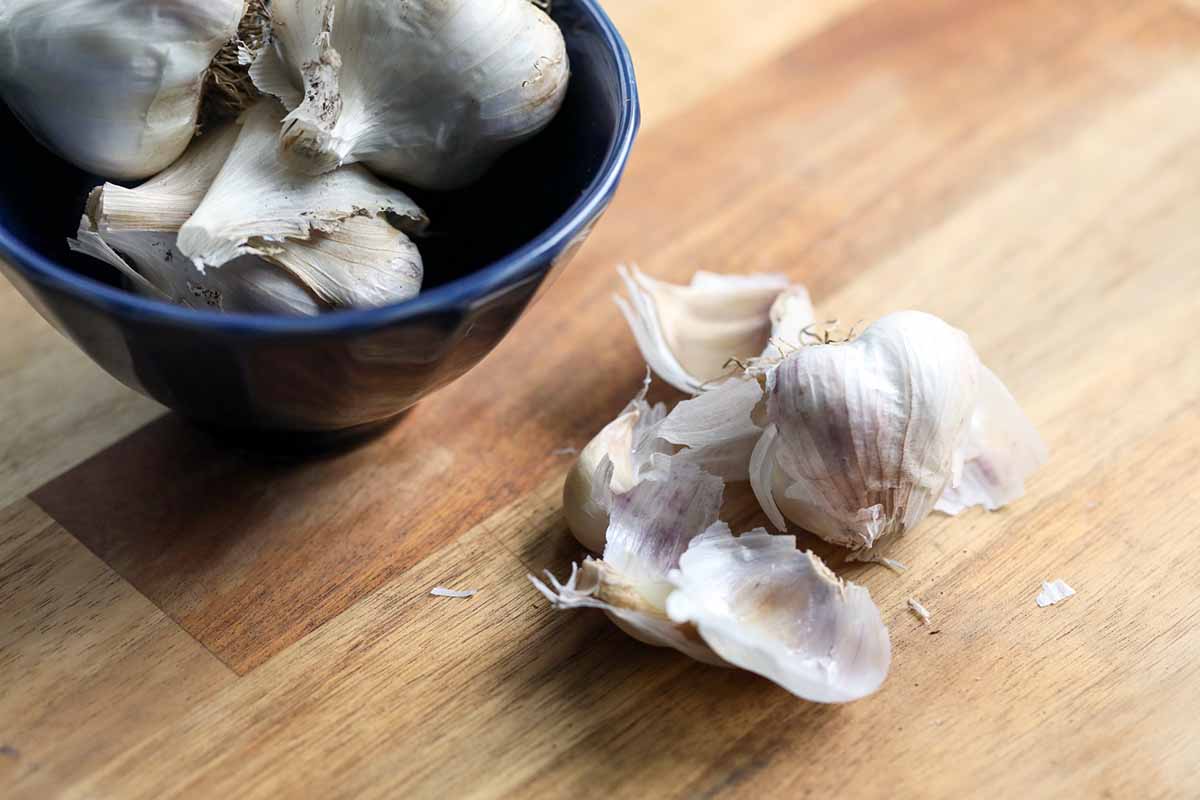
The skin is pure white, hiding large, teardrop-shaped cloves with mottled purple skin. The bulbs are large and contain four to six large cloves each.
If you like your garlic raw but not too hot, ‘Polish Hardneck’ will please. It has a pungent, full flavor without being too spicy when eaten raw.
Cooked, it maintains its pungency with a deep, rich flavor. Many people rate it as one of their favorite types of garlic. It’s easily one of my favorites for roasting whole.
‘Polish Hardneck’ is a late-harvest type that grows well in cold climates. It thrives in USDA Hardiness Zones 1 to 7. You might be able to coax it to produce in Zone 8, but gardeners in Zone 9 or 10 should go for a different one.
Most porcelains are high in allicin, a sulfuric compound with antibacterial properties that lends most of that classic garlic flavor to the bulbs. ‘Polish Hardneck’ is particularly high in allicin.
Polish Hardneck Garlic Propagation
When it comes to sourcing seed bulbs, go with a reputable seller rather than using something you found at the grocery store to ensure you’re getting healthy bulbs that are ready to grow.
Some growers treat harvested bulbs to prevent sprouting before bringing them to market.
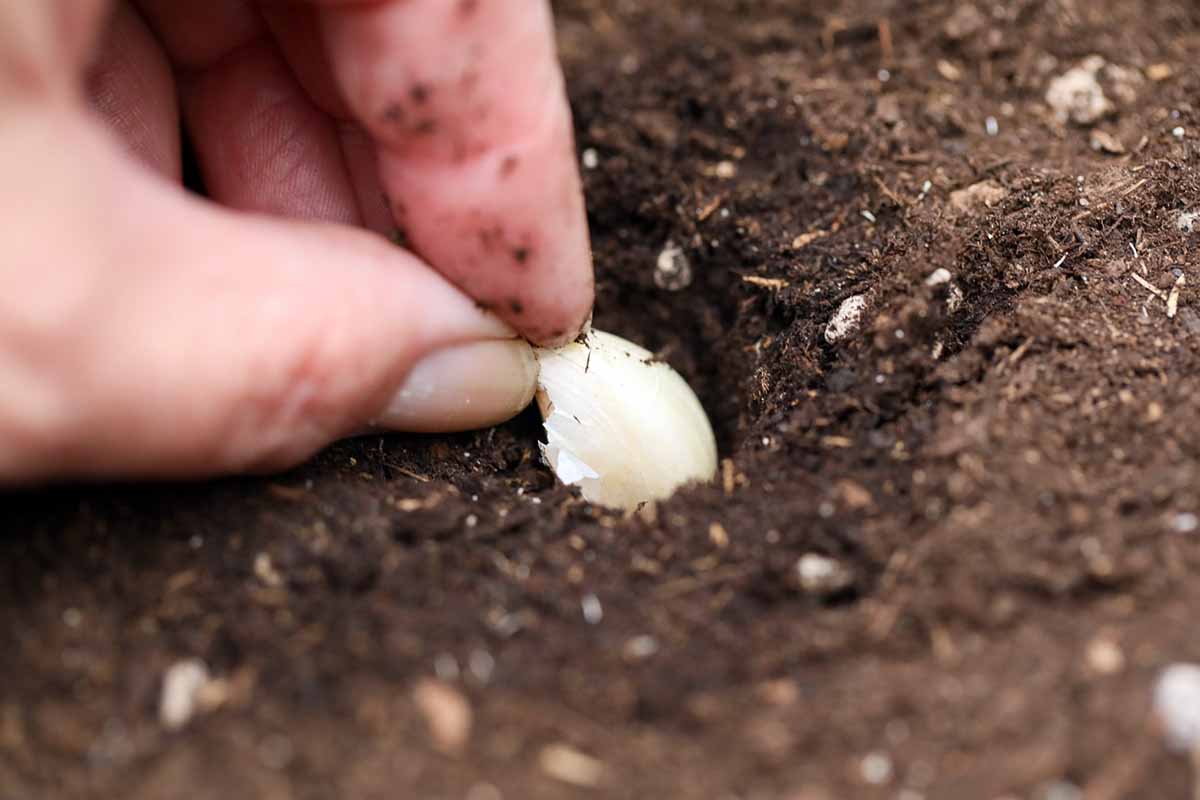
As with most hardnecks, ‘Polish Hardneck’ should be put in the ground about eight weeks before your first predicted frost date.
The plants will go about setting down sturdy roots before they go dormant for the coldest months. They’ll probably also send up a few green shoots. Once the warmer spring weather arrives and the days begin to get longer, they’ll get straight to growing.
Seed cloves should be placed about three inches deep and six inches apart. Don’t remove the wrapper when you place each clove in the ground. Cover with soil and water well.
If you live in Zone 7 or lower, add a few inches of sawdust, straw, or shredded bark to protect the bulbs.
Read more here if you’re looking for more thorough instructions to propagate garlic.
How to Grow Polish Hardneck Garlic
These plants do best with full sun and loose, well-draining soil. If you have heavy clay soil like I do, consider growing your garlic in containers or raised beds.
Once the plants start to show new growth in the spring, which typically happens a month or so after the shortest day of the year and once the temperatures regularly climb above 45°F, remove any mulch you put in place.
Be careful not to disturb the plants. Any damage at this point can introduce pests or disease.
If you’d like to suppress weeds and help retain moisture, you can put down another layer of fresh mulch. Make this one about an inch thick.
Speaking of moisture…
More so than many other types of garlic, ‘Polish Hardneck’ needs regular moisture. If the roots dry out as they’re developing in the spring, they won’t bulb, or growth might be stunted.
With some types, you want to let the soil become a little bit drier during the month prior to harvest time. But don’t let the soil dry out around ‘Polish Hardneck.’
Keep the soil moist but not wet at all times. It should feel like a well-wrung-out sponge.
Once the plants are growing in earnest and the ground has thawed, it’s time to start feeding. These bulbs aren’t a hungry crop, but they will do best if you give them some extra nutrients.
Any all-purpose food is fine. I personally prefer Down to Earth’s All-Purpose Mix because it comes in a compostable box, is made using natural ingredients, and has never let my plants down.
Down to Earth All-Purpose Fertilizer
Purchase a one-pound, five-pound, or 15-pound box at Arbico Organics.
Cut off the lower stalk as it forms to encourage the plant to put all its energy into growing the bulb. Keep weeds away from your plants, but do your weeding gently and carefully.
You don’t want to go attacking the soil with a rake and end up damaging a bulb or two. It’s best to hand-pull weeds.
Growing Tips
- Plant in full sun and loose, well-draining soil.
- Feed with all-purpose fertilizer in early spring.
- Keep soil moisture even as the bulbs mature.
Where to Buy
As I mentioned, this cultivar is popular with garlic aficionados. Many specialty retailers sell ‘Polish Hardneck.’ Look for it online, particularly in the fall when sellers start shipping their stock.
You can sometimes find it locally, as well. I recently stumbled across some bulbs at a local gardening club, courtesy of a fellow member who had been growing this variety and brought some in to hand out at a meeting.
You never know where you’ll find this flavorful fellow!
Managing Pests and Disease
Remember how we talked about allicin and how it creates that fantastic flavor? The plant didn’t develop allicin to appeal to our taste buds, much as we might like to assume that’s the case.
Allicin is actually a powerful pest repellent. That’s why garlic is used in pesticides and as a companion plant to keep away many insect and herbivore invaders.
No word on whether the allicin is what works against vampires, though.
No plant is totally immune to problems, though. There are pests that apparently don’t mind the sulfuric scent. We have a guide that explains the most common garlic pests and how to handle them.
Bulb mites, leaf miners, nematodes, onion maggots, and thrips are the main baddies you might see.
The main diseases to watch for with ‘Polish Hardneck,’ which is resistant to most fungal issues, are white rot and basal rot. Both of these are difficult to deal with because fungicides don’t work well against them.
Prevention is best in both cases, and involves crop rotation, buying from reliable sellers, and taking care not to damage the bulbs, leaving them exposed to pathogens.
Basal rot is caused by the fungus Fusarium culmorum and exists across the world, so no one is safe. The disease attacks the basal plate of the plant, as the name indicates.
The basal plate is that hard bit at the bottom of the bulb that separates the cloves from the roots.
The extra annoying part here is that you won’t know anything is wrong until the disease is quite advanced, since the damage is mostly happening underground.
You might eventually see yellowing and dying leaves, but by that point, it’s usually too late. You’ll have to pull the plants.
Rotate your crops regularly, only placing alliums in the same place once every four years. You should also source from seed sellers that guarantee their supply is disease-free.
White rot is another fungal issue, this one caused by Sclerotium cepivorum, the reproductive form of Stromatinia cepivora. It’s prevalent in temperate, moist climates and it lives in the ground, even if an allium host isn’t present.
When the fungus attacks a plant, the leaves turn soft and yellow before collapsing. You might also see white, cottony growth or black spotting.
You might have purchased onions or garlic before that gradually developed symptoms like this in storage. That’s because the disease can live on the plant even after it’s harvested.
If you discover symptoms of this disease, pull the plants and dispose of them. You can safely eat the undamaged portions of infected bulbs if you remove and discard the diseased parts.
You can learn more about garlic diseases in our guide.
Harvesting
After about 240 days, a few weeks after the scapes emerge, watch the leaves of your ‘Polish Hardneck’ plants closely.
Once about a third of them have turned yellow or brown and have fallen over, it’s time to harvest your garlic.
If you’re ever in doubt, dig up a test bulb. Peel a few cloves and give them a taste. Is the texture and flavor as it should be? Great, gently dig up all the rest of the bulbs. If not, wait a week and test again.
Don’t pull the plants by the tops, or you run the risk of tearing the greens out of the bulb. Instead, gently dig underneath the bulb with a shovel or fork and gently pry the plant up.
Curing and Storing
If this is your first time curing garlic, read our guide to see how the process works. Cured hardneck garlic can generally store for anywhere from three to six months.
‘Polish Hardneck’ is somewhere right in the middle, lasting for up to about four months.
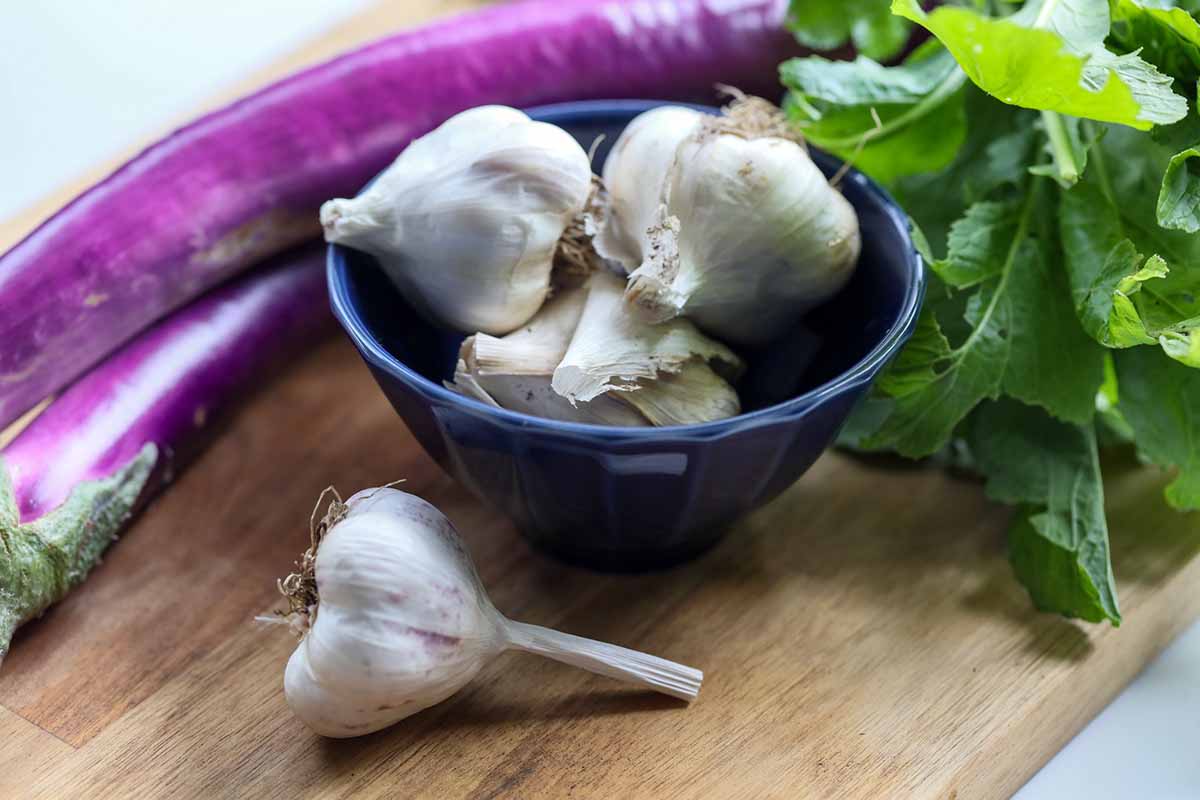
If you like pickled or fermented garlic, this is a good cultivar for that. The large cloves retain all their moisture and taste just as good a year down the road.
You can also freeze the peeled cloves by mincing them up and placing them in resealable bags. Press out all of the air and toss them in the freezer for up to a year.
Recipes and Cooking Ideas
The skin comes away easily from ‘Polish Hardneck’ cloves, so if you’re like me and hate peeling garlic, you’re going to love using this variety. And as I said, it’s a favorite of mine for roasting whole.
I can make an entire dinner out of roasting some fresh garlic and smearing it on sourdough bread dressed in olive oil.
I smash the cloves on top of the bread, and top it with a little chopped tomato tossed with chopped parsley, oil, and salt, and a drizzle of excellent balsamic vinegar.
If you like a good, strong bit of garlic flavor and you aren’t planning on making out with anyone that night, use the finely chopped cloves in your favorite guacamole recipe.
Don’t have a go-to of your own? Try this one from our sister site, Foodal.
Quick Reference Growing Guide
| Plant Type: | Allium bulb vegetable | Tolerance: | Freezing Temperatures |
| Native to: | Ontario, Canada | Soil Type: | Loose, rich |
| Hardiness (USDA Zone): | 1-8 | Soil pH: | 6.0-7.0 |
| Season: | Fall-summer | Soil Drainage: | Well-draining |
| Exposure: | Full sun | Attracts: | Flowers attract pollinators |
| Time to Maturity: | 240 days | Companion Planting: | Brassicas (repels pests) |
| Spacing: | 6 inches | Avoid Planting With: | Other alliums |
| Planting Depth: | 3 inches | Order: | Asparagales |
| Height: | 18 inches | Family: | Amaryllidaceae |
| Spread: | 6 inches | Genus: | Allium |
| Water Needs: | Moderate | Species: | Sativum |
| Maintenance: | Low | Variety: | Ophioscorodon |
| Common Pests and Disease: | Bulb mites, leaf miners, nematodes, onion maggots, thrips; basal rot, white rot | Cultivar: | Polish Hardneck |
The Garlic Lover’s Garlic
Everyone who tastes this garlic falls in love with it. It’s rich and spicy with plenty of depth, but it won’t make you cry with its pungency.

If you haven’t tried it, yet, you need to make it happen. It’s fantastic.
How do you plan to use your ‘Polish Hardneck’ harvest? Share your recipes in the comments!
Looking for some other interesting types of garlic to add to your garden? Check these out next:
